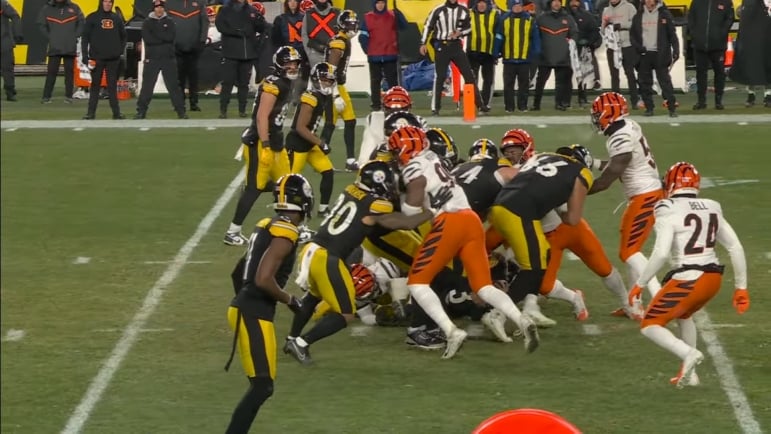There’s no question the Pittsburgh Steelers’ offense has underachieved in 2024 and for several years before that. While the offense technically had its best finish since 2020, 16th in points per game, the season ended with a historically bad finish, and the overall results were still poor. The problems are obvious. What are the solutions? Below are four stats the Steelers’ offense must turn around to be happy with their 2025 results.
Red Zone – 48.2 percent (29th)
This is an obvious one discussed throughout the year. Pittsburgh struggled inside the opposing 20 all season long, and it’s a key reason why kicker Chris Boswell kicked a team-record 41 field goals and led the NFL in scoring. The Steelers could make their way downfield, but punching it in was a significant challenge. The Steelers’ red zone production has been ugly for years, finishing somewhere in the 20s each of the past four seasons. The 2024 campaign was their worst ranking.
Pittsburgh has to start making headway here. That means a strong running game, better route combinations, and finishing plays. Penalties and miscues prevented the Steelers from a couple more should-be scores last year.
Short-Yardage – 57.6 percent (29th)
This was an area I harped on throughout the season, and it shouldn’t be forgotten. The Steelers were miserable in the most makeable situations last year. On 3rd/4th down needing 1-2 yards, Pittsburgh converted barely more than half the time. Comically, there were games where the team completely came up empty, including their upset loss against the Cleveland Browns.
Breaking it down by play type, the Steelers converted 52.2-percent through the air (20th) and 61.1-percent on the ground (29th). More successful on the ground, but a lower ranking relative to the NFL.
Yards Before Contact Rushing – 2.2 yards (24th)
Pittsburgh’s runners had little room to work with last year. For a team that finished fourth in rushing attempts, averaging 2.2 yards per rush before contact is a paltry figure. Perhaps a lack of explosiveness from Najee Harris, a back who did his best seeking contact, played a role in this figure, but Kaleb Johnson will need to have his number come in much higher.
Of course, that will rely on an offensive line to open lanes for him and Jaylen Warren, too. If Pittsburgh is going to be a run-first unit, and they will be, they have to be an efficient one, too.
Pressure Rate – 25.3 percent (Tied-29th)
Pittsburgh’s offensive line, coupled with quarterbacks who ran into pressure and held onto the ball too long, led to plenty of pressure. More than one-quarter of the Steelers’ dropbacks ended in it, and it was especially pronounced during the five-game losing streak to close out the year. The young offensive line must develop—it’s the number one point I’ve harped on—and the quarterbacks need to play more in structure.
Adding Aaron Rodgers should significantly reduce the lengthy snap-to-throw times of Justin Fields (3.04 seconds, 40th among qualifying quarterbacks) and Russell Wilson (2.86 seconds, 28th). However, no matter the explanation, the pressure rate must come down.








